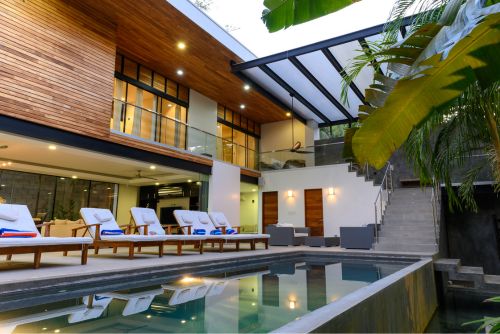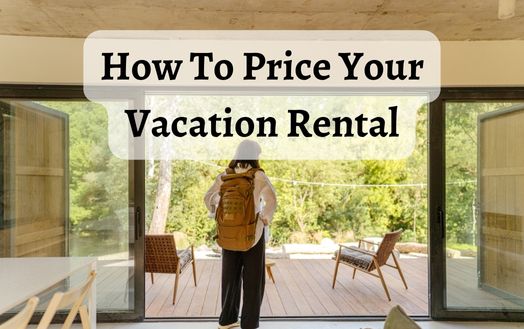How To Price Your Vacation Rental
Are you ready to embark on a journey towards maximizing your vacation rental’s revenue potential? Look no further, because in this article, we’re going to dive into the exciting world of how to price your vacation rental.
As avid travelers ourselves, we understand the importance of finding that sweet spot where your rates are enticing enough for guests while still generating the profits you deserve. In today’s competitive market, simply setting a price and hoping for bookings is not enough. We need to think strategically and tap into innovative ways of optimizing our revenue.
From analyzing competition to adjusting prices based on demand, we’ll explore effective techniques that will make your vacation rental stand out from the crowd.
So get ready to unlock the secrets of successful pricing – let’s delve into this exciting adventure together!
How To Price Your Vacation Rental
Vacation rental pricing can be tricky. With so many variables, it’s crucial to create a pricing strategy that maximizes rental income while remaining competitive. Research local vacation rentals to set your rates. Check their prices and occupancy rates to see what guests will pay.
The season also affects vacation rental pricing. Off-peak times may require lower prices to attract guests, while peak seasons may allow higher rates. Consider local events and festivals that may affect demand and adjust your rates.
Analyze your vacation rental’s unique features and amenities, along with competitors and seasonal variations. Are there pools, hot tubs, or gorgeous views? These amenities can increase property values. Remember that guests will pay more for great experiences.
Don’t forget taxes and cleaning fees when pricing your vacation rental. These costs must be covered and factored into your pricing strategy. You can ensure profitability and fair pricing for guests by carefully assessing all relevant expenses and incorporating them into your rate calculations.
As we move into the “factors to consider” section, it’s clear that pricing your vacation rental requires careful consideration. Developing a pricing strategy involves more than just researching competitors’ rates and seasonal fluctuations.
Factors To Consider

Location, amenities, and demand affect rental property pricing. These factors determine the best vacation rental price.
Start with your property’s location. Is it a tourist attraction or remote? Nearby attractions, beaches, and city centers can affect pricing. Consider your amenities too. Does your rental a private pool or spa? Perks can justify higher rates.
Market competition is another consideration. Compare the prices of nearby vacation rentals. Compare your amenities to theirs to determine your value proposition. Online pricing tools provide market trends and competitor rates. This will help you maximize profit and market position.
Additionally, monitor seasonal demand changes. Consider peak seasons when festivals and events draw tourists. Increasing prices during peak demand can boost revenue without affecting occupancy rates.
Location, amenities, competition, and seasonal demand all affect vacation rental pricing. By analyzing these factors and using online pricing tools, you can set competitive rates that maximize property profitability.
In the next section, “Determining Rates,” we’ll discuss how to price your vacation rental without undervaluing it.
Determining Rates
Imagine potential guests enjoying your property’s stunning views to find the right vacation rental rate. Vacation rentals offer an unforgettable experience. Consider your property’s location, amenities, and appeal when setting rates. Knowing what makes your vacation rental unique lets you price it correctly.
Pricing must balance profit and guest appeal. It’s crucial to study nearby vacation rentals’ pricing strategies. To estimate rates, compare similar properties, locations, and target markets. Competitive rates don’t mean undercutting other rentals; they mean offering comparable value at a fair price.
Seasonality also affects rates. Demand affects prices year-round. Vacationers seeking sun and sand may pay more for beachfront properties in peak summer months. However, off-peak seasons may require lower prices or discounts to attract guests.
By carefully analyzing these factors—your property’s unique features, market competition, and seasonal demand—you can set vacation rental rates. Knowing your property’s strengths helps you market it competitively.
After determining vacation rental rates, let’s analyze the competition without missing any details!
Analyzing Competition

Analyzing your competition and gaining a vacation rental market edge is exciting! Pricing your vacation rental requires competitive analysis. You can create a unique pricing strategy by studying local rentals.
Research rental prices for properties like yours in size, location, amenities, and quality. This will show how much guests will pay for a comparable experience.
After collecting rental price data, analyze the competition. Identify pricing patterns. Are there seasonal discounts? Demand-based pricing? Knowing how your competitors price rentals will inform your dynamic pricing strategy.
Offer unique or extra value to stand out. You could lend guests bikes to explore the neighborhood or recommend local restaurants and attractions. Providing extras may make guests pay more for your vacation rental.
Pricing your vacation rental requires competitive analysis. Research rental prices and competitors’ pricing strategies to create a dynamic pricing strategy that sets you apart.
Seasonal Pricing
Use seasonal pricing strategies to maximize profits. Seasonal pricing lets you adjust vacation rental rates based on demand and occupancy trends. This strategy lets you attract more guests during peak seasons and keep bookings steady during slower periods.
Consider these factors for vacation rental seasonal pricing:
- Demand fluctuations: Understanding when your destination experiences high and low tourist activity is crucial. Research the local events, festivals, and holidays that attract visitors to your area. By aligning your rates with these peak times, you can capitalize on increased demand and charge higher prices.
- Occupancy levels: Analyze historical data to identify patterns in occupancy rates at different times of the year. Adjusting your prices accordingly will help ensure maximum occupancy without undervaluing or overpricing your property.
Seasonal pricing strategies optimize revenue and create urgency among potential guests looking for an exclusive deal during popular travel seasons. It balances profits and year-round bookings.
Before moving on to “special events,” it’s important to note that these events affect vacation rental demand and prices.
Special Events

Special events can affect booking trends throughout the year. A music festival, sporting event, or conference can draw many visitors looking for accommodations. Vacation rental owners can capitalize on high demand by raising prices.
Special events can boost revenue and distinguish your property. Keep up with local events to price your vacation rental during special events. Track local festivals, concerts, and conferences that may attract tourists. Use vacation rental pricing software to adjust rates after identifying special events. These tools help property owners optimize rates by considering location, seasonality, market demand, and competitor pricing.
Pricing your vacation rental during special events requires balancing profits and competitiveness. During busy periods, it’s tempting to raise prices, but this may deter guests. Check what other properties in your area are charging during these events to make sure your rates are reasonable. You can increase guests and revenue by offering competitive pricing and taking advantage of special event demand.
Understanding how special events affect vacation rental rates will help you adjust prices during holidays in the next section. Christmas and New Year’s Eve rates are set similarly. Now, holiday pricing strategies!
Holiday Pricing
After discussing special events and vacation rental pricing, let’s discuss holiday pricing.
The holidays are a time to relax and make memories with family. Vacation rental owners must capitalize on this demand by setting competitive rates that attract guests. Your vacation rental’s holiday pricing adjusts during peak seasons like Christmas, Thanksgiving, New Year’s Eve, and others. As families and friends celebrate, hotel demand rises. You can distinguish your property by offering market-based rates. But don’t get carried away with holiday prices. Due to high demand, it may be tempting to charge exorbitant rates, but guests want value.
Profitability and affordability must be balanced. Consider location desirability, amenities, and past booking data when setting holiday pricing for your vacation rental. Analyzing past trends can reveal holiday guest spending. Monitor your competitors’ rental rates to stay ahead.
As we discuss vacation rental pricing strategies, location and area matter. The next section will discuss how the neighborhood and attractions affect the perceived value of your property and the price you should charge guests. Let’s examine how location can give your vacation rental an edge in attracting discerning travelers seeking unforgettable experiences at affordable prices.
Location And Area

Your vacation rental’s idyllic surroundings and attractions may attract discerning travelers seeking unforgettable experiences. Pricing your vacation rental depends on location and size. Travelers often choose hotels near popular attractions, scenic areas, or lively cities. Highlighting these features in your property listing can attract guests who prioritize location.
It’s important to consider local demand for similar properties when pricing your vacation rental. Consider the average rates of nearby rentals and any unique features yours has. You can charge more if your property is in a desirable area with limited availability. If your area has many options, you may need to adjust your pricing strategy.
Showcase nearby attractions and activities to enhance guests’ stays. Potential guests will value your vacation rental more if you highlight landmarks, outdoor activities, shopping districts, or cultural events. Emphasize how close your property is to these attractions to attract travelers seeking memorable experiences.
When pricing your vacation rental, take location into account. Consider the supply and demand for nearby properties. Highlight nearby attractions and activities to attract guests seeking unforgettable experiences. Understanding how location affects pricing and promoting these qualities in your property listing can attract discerning travelers who value convenience and innovation.
Booking Strategies
Effective booking strategies can help you on how to price your vacation rental and maximize your vacation property’s revenue. Three key booking strategies can help you achieve this:
- Utilize data analytics: In today’s digital age, data is power. By analyzing the data from previous bookings and customer preferences, you can gain valuable insights into the optimal pricing and availability for your vacation rental. Use this information to identify peak booking periods, popular holidays, and other factors that influence demand in your area. Data analytics can also help you understand customer behavior patterns and adjust your marketing efforts accordingly.
- Offer flexible booking options: In a world where people’s schedules are constantly changing, offering flexibility in your booking options is key. Consider allowing guests to book for shorter or longer stays than the standard week-long rental period. You could also offer mid-week check-ins or check-outs to accommodate different travel plans. By being flexible with your booking policies, you can attract a wider range of guests who may have specific needs or preferences.
- Leverage online platforms and social media: The internet has revolutionized the way we search for and book accommodations. To reach a larger audience and increase bookings, it’s crucial to list your vacation rental on popular online platforms like Airbnb, HomeAway, or Booking.com. These platforms not only provide exposure but also allow potential guests to easily browse through reviews and compare prices. Additionally, don’t underestimate the power of social media in promoting your property. Share captivating photos and engaging content on platforms like Instagram or Facebook to generate interest among potential guests.
These booking strategies—data analytics, flexibility in bookings, and online platforms—can boost revenue and guest satisfaction for your vacation rental property.
To maximize bookings, listing descriptions and unique amenities must be optimized.
Maximizing Bookings

We can increase bookings by optimizing listing descriptions and highlighting unique amenities. Showing what makes our vacation rental unique may help us get more bookings. Emphasizing our property’s views, pools, and proximity to attractions will draw more guests.
Write compelling listing descriptions that vividly describe the guest experience. Our property’s hiking trails and nearby restaurants should be highlighted. We can attract adventurous vacationers who want something special by providing this information upfront.
Online platforms and property management tools can boost bookings. These platforms help us promote our vacation rental across multiple channels and reach more people. They also help us tailor our marketing by revealing market trends and guest preferences.
Finally, competitive pricing can boost bookings. Finding the right price-value balance is crucial. We can determine market pricing by researching nearby properties. We can increase bookings without undervaluing our vacation rental by setting competitive prices that meet guest expectations.
We can maximize bookings for our vacation rental property by optimizing listing descriptions, highlighting unique amenities, using online platforms for marketing, and setting market-competitive prices. These strategies will attract guests who want a unique and affordable travel experience.
Setting Competitive Prices
Maximizing vacation property bookings requires balancing affordability and value. To attract guests and stand out in a crowded market, set competitive vacation rental prices. Consider location, amenities, seasonality, and market demand when setting rental prices.
Researching local vacation rental rates helps set competitive prices. You can estimate guest prices by studying the market value of nearby properties. This information can help you price your rental affordably.
Your property’s unique features and amenities should be considered along with rental rates. Are your vacation rental’s amenities unique? Consider how these extras enhance guest value. If your property has stunning views, high-end furnishings, or exclusive access to recreational facilities, you can charge more.
Find the balance between affordability and value to maximize vacation rental bookings. A competitive price will attract budget-conscious guests looking for quality accommodations. This can increase occupancy rates and host revenue.
Remember that pricing can be changed without saying “step” when adjusting prices. Market trends and guest feedback should be used to regularly adjust rental prices. Flexibility lets you meet changing demands while offering a good deal.
Adjusting Prices

Vacation rental pricing requires flexibility. Stay ahead of market trends and guest demands by constantly adjusting rental prices. This boosts bookings and appeal. How can you make your vacation rental prices competitive and appealing?
Let’s explore three sub-lists that will help paint a vivid picture in your mind.
- Stay aware of seasonal fluctuations: Just like any business, vacation rentals experience seasonal highs and lows. Adjusting prices based on these fluctuations is crucial for optimizing revenue. During peak seasons, such as summer or holidays, demand tends to increase, allowing you to charge higher rates. Conversely, during off-peak times, reducing prices can attract more guests who are looking for affordable options.
- Keep an eye on local events: Is there a music festival happening nearby? Or maybe a major sporting event? These types of local events can significantly impact the demand for vacation rentals in the area. By adjusting your prices accordingly, you can capitalize on the increased demand during these periods. Higher rates during event dates can help maximize revenue while still offering value compared to other accommodation options.
- Monitor guest feedback and reviews: Pay close attention to what guests are saying about their experiences at your vacation rental. If they consistently mention that the price was too high for what they received or if they suggest that certain amenities could be improved, it may be time to reevaluate your pricing strategy. Adjusting prices based on guest feedback shows that you value their opinion and strive to provide them with a fair deal.
You can maximize vacation rental revenue while following market trends by being flexible and adjusting prices based on seasonality, local events, and guest feedback. Pricing adjustments are only part of maximizing property profits. Next, we’ll discuss “optimizing revenue” to keep your vacation rental profitable.
Optimizing Revenue
Optimizing revenue for your vacation rental property will maximize profits. One way is to carefully consider and adjust your pricing rates. Market trends and demand patterns can help you identify peak seasons or times to charge more. However, during off-seasons, you may need to lower your prices to attract bookings.
Other methods can boost vacation rental revenue besides demand-based price adjustments. Offering discounts or special promotions at certain times of the year can fill booking gaps. Instead, offer discounts for longer stays with tiered pricing. This increases guest stays and revenue.
Vacation rental technology and data analysis tools can also boost revenue. These tools reveal market trends, competitor pricing, and guest preferences. Use this data to adjust your pricing strategy. Effective pricing can keep your vacation rental property competitive and profitable.
Next, we’ll discuss pricing strategies that will help you meet these goals without sacrificing guest satisfaction or occupancy rates.
Effective Pricing Techniques

Use competitive vacation rental pricing to maximize your property’s revenue. Pricing your rental correctly attracts guests and maximizes revenue. Market research can help you set rental rates for nearby properties. This will help you price your property competitively and attract guests.
Consider seasonal demand and adjust your prices. Vacation rentals are in demand during peak seasons and holidays, so you can charge more. However, lowering prices during off-peak periods can increase bookings and ensure a steady stream of guests throughout the year.
Offer discounts for longer stays or last-minute bookings to maximize revenue. Special deals can boost occupancy and revenue during slow periods. Dynamic pricing software automates rate changes based on availability, demand, and competitor analysis. These pricing strategies can boost your vacation rental’s revenue while keeping it competitive. Rate management is only one part of a successful vacation rental business.
In the next section, “managing rates,” we’ll discuss how to handle rate changes and adjustments while ensuring guest satisfaction, profitability, and quality accommodations.
Managing Rates
Vacation rental rate management can maximize revenue and guest satisfaction. Pricing your vacation rental is crucial because it affects revenue and attracts guests.
Here are three key points to consider when managing rates:
- Understand the market: Researching the vacation rental rates in your area is essential to ensure you’re competitive. Check out similar properties on popular rental sites and see what they’re charging. This will give you an idea of the current market trends and help you price your vacation rental accordingly.
- Seasonal adjustments: Consider adjusting your rates based on seasonal demand. During peak travel seasons, such as summer or holidays, you can charge higher prices since there’s typically more demand for accommodations. Conversely, during slower seasons, offering discounted rates or special promotions can attract more guests and help fill up your calendar.
- Dynamic pricing: Implementing dynamic pricing strategies can maximize revenue by adjusting rates based on factors like availability, occupancy rate, or even local events happening nearby. By using data-driven tools or software specifically designed for managing vacation rental rates, you can automate this process and optimize prices in real-time.
Rate management keeps you competitive and maximizes vacation rental profits. Understanding the market, seasonal adjustments, and dynamic pricing strategies can help you attract guests and maximize revenue.
In the ever-changing vacation rental industry, using these pricing strategies shows innovation and foresight. Hosts who match market prices and offer value are appreciated. So go ahead—manage rates for your vacation rental business and see how it improves guest satisfaction and profitability.
Final Thoughts
Pricing your vacation rental is essential to maximizing revenue and attracting guests. Location, amenities, and demand can help you set the right property rates. Analyzing market competition will help you set prices that match nearby rentals.
Seasonal pricing is also important. Adjusting prices for peak travel seasons can help you maximize profits. However, discounting rates during low-demand periods can increase bookings and ensure year-round bookings.
Review and adjust prices based on market trends and guest feedback to maximize revenue. Dynamic pricing and promotions can also boost bookings and profitability.
Rate management requires constant market, competitor, and guest analysis. These strategies and proactive price adjustments can keep your vacation rental competitive and maximize earnings. Follow this guide on how to price your vacation rental and ensure a maximized profit.
Frequently Asked Questions
How Can I Attract More Guests To My Vacation Rental Property?
We need to be creative to attract more guests to our vacation rental property. We should give our guests an unforgettable experience rather than just a place to stay. This could include smart home features or virtual reality. We satisfy our audience’s subconscious desire for novelty by embracing innovation.
We can also promote nearby attractions, host exclusive events, and give guests personalized recommendations based on their interests. By pushing boundaries and thinking creatively, we will attract more guests and leave a lasting impression that keeps them coming back.
What Are Some Effective Strategies For Increasing Bookings During Low Season?
Creative thinking is needed to boost low-season bookings. Offering special promotions or discounts to guests who book during this time can work. This will increase visitors and lengthen their stays.
Another option is to work with local businesses and attractions to create off-season packages that showcase our destination’s best. We can appeal to our audience’s subconscious desire for innovation by offering seasonal experiences.
Targeted online marketing and social media advertising can help us reach more low-season travelers. Even when demand is low, we can maximize bookings by being proactive and finding new ways to engage guests.
How Can I Adjust My Prices To Accommodate For Unexpected Events Or Changes In Market Demand?
We must constantly analyze and adjust our pricing strategy to account for unexpected events and market demand. We can maximize rental income by closely monitoring market trends and major events.
Dynamic pricing tools that consider seasonality, local events, and weather patterns can help us maximize occupancy and revenue. Offering discounts or promotions during slow periods can also attract guests and maintain bookings.
We can overcome obstacles and seize vacation rental market opportunities by being flexible and adaptable.
Are There Any Tools Or Resources Available To Help Me Analyze The Pricing Strategies Of My Competitors?
There are tools to analyze our competitors’ pricing strategies. Understanding how our competitors price their vacation rentals helps us understand market trends and make better pricing decisions.
Competitive analysis software helps us track and compare prices across platforms in real time. This software provides occupancy rates, booking patterns, and competitor pricing. OTAs can also show us how similar properties are priced in specific locations. We can stay competitive and maximize our vacation rental’s profitability by using these tools and resources.
What Are Some Common Mistakes To Avoid When Setting Prices For My Vacation Rental Property?
We must avoid common mistakes when pricing our vacation rental property. First, don’t underprice our property. Lowering the price to attract more guests can devalue the experience and make potential renters question the quality of our rental. Overpricing can deter guests and lengthen vacancies.
We should also avoid basing prices on personal preferences or emotions. Instead, we should consider market data and trends, including location, amenities, and demand.
Finally, seasonal pricing must be considered. Rates adjusted for peak travel times or nearby events can boost occupancy and revenue. Avoiding these mistakes and using data can help us price our vacation rental competitively and offer guests a unique experience. This will increase guest numbers and vacation rental business profits.











